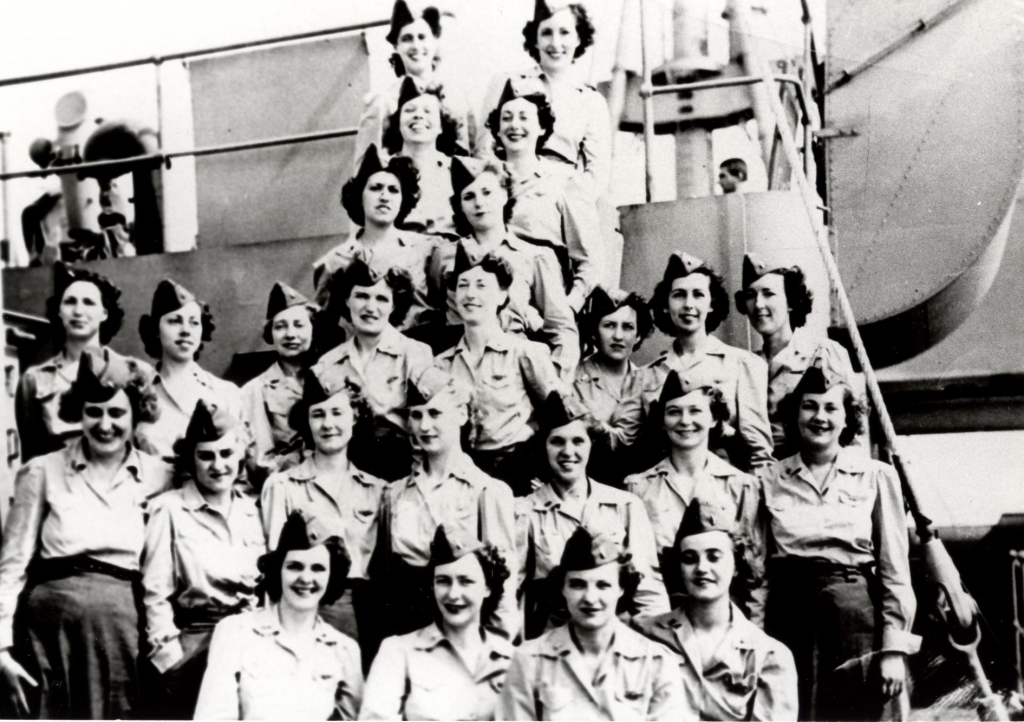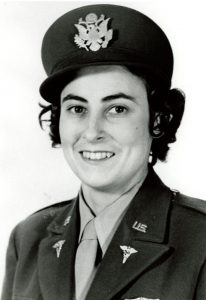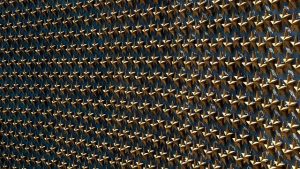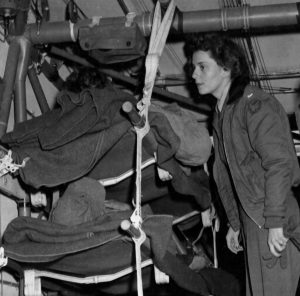The Twenty–sixth in a series of Blogs about the 31 Medical Air Evacuation
Transport Squadrons activated during WW2
to provide inflight nursing care to sick and wounded soldiers,
tended by Army flight nurses and enlisted technicians.
The focus is on the flight nurses.
Reinforcements Arrive
820 MAETS Activated November 1943
821 MAETS Activated January 1944
822 MAETS Activated January 1944
With the war in Europe won, the Allies turned to the Pacific and the defeat of the Japanese. The change in focus necessitated additional air evacuation squadrons to handle the increased casualties resulting from the intensified fighting as troops advanced toward and captured the remaining islands on the way to the Japanese mainland. In the Pacific, the Philippines were the target of Allied attacks; in the CBI, American bombers stationed in India staged raids on Japan from bases in China before the Marianas were used for staging; and in the North Atlantic, air evacuation activity stepped up to bring wounded soldiers home to the US from Europe. The Allies also were fighting the lengthy Burma Campaign hampered by monsoon rains to defeat the Japanese armies in the theater while completing the Burma Road.
After their squadron’s sea voyage from San Francisco across the Pacific to Milne Bay, New Guinea, on 19 March 1944, the 820 MAETS flight nurses were flown to Port Moresby on Temporary Duty to work in conjunction with the 804 MAETS flight nurses. “[A]nd so by devious routes the 820th started operation but not as a squadron,” wrote the unit historian. The rest of the squadron joined the nurses in April, which “brought with it what was probably one of the biggest moments in the life of the 820th, namely, the beginning of our operation as a squadron in the performance of our assigned mission”. 1
A month later the squadron was on the move again, to Nazdab, where the 820 MAETS flight nurses were billeted away from their own squadron and near the 804 MAETS nurses. With the 804 MAETS handling all air evacuation operations until the 820 MAETS got settled in their new campsite and with the 820 MAETS flight nurses housed away from the main body of personnel, the squadron felt subordinate – “Rather than maintaining our own identity, we were actually becoming a satellite organization of the 804th.” 2 Flight nurses and enlisted technicians were flying to Hollandia, Momote, Tadji, Fincshhaven, Dobodura, Dumpu, and other bases. 3 In June the 820 MAETS was sent to Hollandia but had to leave its flight nurses behind in Nazdab. The nurses finally rejoined their squadron in August. “This was a happy day for us. Once more we were a Unit. The technicians had been doing and [sic] adequate and excellent job but no one doubted we would become more efficient, and that patients would benefit from better care in evacuation from forward areas.” 4 In their first 6 months in New Guinea the 820 MAETS had operated as a unit in only 4 but had flown over 10,000 patients in over 850 missions covering over 3,000,000 patient miles without a patient death or fatal accident. 5
The 804 MAES moved to Biak in October 1944, taking over evacuation of Biak and Moroti, leaving the 820 MAES only Owi, Nemfoor, and Samsipor to evacuate. That same month the men of the 820 MAES were alerted for movement to Leyte in support of the Philippines Campaign; the flight nurses were to work with the 801 MAES and 804 MAES already in Biak. The linking up of these flight nurses from 3 MAES was not without its humorous moments. As the unit historian for the 804 MAES reported in November 1944, “the 820th nurses arrived bag and baggage. Included were a cat and about 3 or 4 dogs. One of these was a Great Dane pup, already the size of a Shetland pony. We looked at him rather dubiously and scanned our [food] ration requests with an anxious eye.” 6
In his December 1944 historical report, 804 MAES flight surgeon Hugh Crumay, who was with the contingent of men in Leyte, wrote, “No permission for nurses to fly forward could be obtained. Nurses were already stationed in the area, and there were adequate R.O.N. [Remain Overnight] facilities for nurses who might be forced to stay overnight in forward areas, as well as at all stops along the way.” 7 That same month the Fifth Air Force ordered the 820 MAES flight nurses to fly into Leyte, where the 820 MAES and 804 MAES established a pool of their flight nurses for air evacuation missions. 8 In January 1945 the squadron historian expressed concern that the 820 MAES flight nurses could not fly forward to Mindoro, where ground nurses already were stationed and flight nurse quarters had been completed.
The entire policy of not allowing nurses to fly into forward areas defeats the entire purpose of organized Air Evacuation. It is early in the campaigns that the really wounded and injured are being evacuated and it is these men that need the expert care that only a trained nurse can give. 9
By the end of January, flight nurses were permitted to fly into Mindoro. 10
On the morning of 23 January 1945 flight nurse Thelma La Fave and 2 enlisted technicians had taken off from Peleliu Island to evacuate patients from the Tacloban airstrip on Leyte. Weather conditions were apparently good at time of take-off, but the plane never arrived at any airstrip on Leyte – it simply disappeared. No contact had been made with the plane after take-off from Peleliu. The 804 MAES, with whom the 820 MAES worked closely, broke the news that La Fave was considered Missing in Action. 11
In February the 820 MAES nurses still flying out of Biak rejoined their squadron in Leyte. That same month 2 of the squadron’s nurses had a memorable mission when, on their way to Mabalacat in Luzon to pick up patients for air evacuation, the flight crew got lost, fuel ran low, and the pilot decided that ditching was inevitable. The flight nurses prepared for the water landing, filling their pockets with medications and supplies, donning their life vests, and strapping themselves in securely for impact. The plane’s occupants got the life rafts out before the aircraft sank, tied them together, and rowed away from the nearby enemy–occupied island; the flight nurses bandaged the injuries sustained. Catalina aircraft rescued the survivors the next morning and flew them to Navy boats, where they were “treated wonderfully”, the flight nurses reported, with hot showers, clean clothing, “a drink of American liquor”, and lunch served on a white tablecloth – all of which, they said, made them forget what had happened. 12
The 820 MAES experienced another tragedy when on 10 March 1945 the plane on which flight nurse Martha Black and an enlisted technician were transporting 30 patients from Mabalacat to Leyte never arrived at its destination. The Tanuan Tower received a weak emergency message from the plane requesting 5 ambulances and landing instructions, but tower personnel could not reestablish contact. With the rain and poor visibility at the time, officials speculated that the plane may have drifted off course, run out of gas, and crashed somewhere in Mindanao. The wreckage was found 7 weeks later in northern Leyte, where it had been on final approach to the Tanuan airstrip. Squadron members were consoled only with the knowledge that apparently no one had suffered and that death had been instantaneous. 13
“April 1945 saw the enemy taking it on the chin in all theatres, and the 820th was still in there doing its share,” wrote the unit historian. 14 The 820 MAES still was operating in conjunction with the 804 MAES, dividing flights on the basis of originating airstrips. An Intelligence summary included in the squadron history that month noted the factors favorable to good morale in the 820 MAES: “a comfortable and well–policed” campsite; a balanced diet; adequate recreational facilities; regular mail delivery; improvement in type of movies shown; a Post Exchange running smoothly; and arrival of nurse replacements. Factors adverse to good morale were fewer and included unavailability of R&R leaves; continued reduction in operational air evacuation flights; poor weather conditions; and lack of a sufficient beer ration. 15 By the next monthly report, word of V–E Day had boosted squadron morale even higher.
In June the men of the 820 MAES moved to Okinawa; the flight nurses remained behind in Luzon in the area of Clark Field flying with the 804 MAES until the new campsite could accommodate them. The nurses of both squadrons arrived in Okinawa in August at the current Mobutu campsite where the 2 squadrons worked together. It was to be a short stay before moving on to the Japanese mainland to provide medical crews for intra–island air evacuation missions. Both squadrons moved to Tachikawa, Japan in September 1945, but a typhoon and continued bad weather suspended flights on the mainland, “and air evacuation work dwindled as operations entered the post–hostilities period”. 16
The 821 MAETS flight nurses knew what it was like to be a satellite to another MAES. When they arrived in India with their squadron in early July 1944 after a lengthy sea voyage from the US, 3 Flights of the 821 MAETS joined up with the veteran 803 MAETS in Chabua for orientation on regularly scheduled air evacuation trips before sharing trips from India and from Burma equally. They made their first “independent” air evacuation flight as a unit in August. 17 Flight C of the 821 MAES was sent to Kunming, China, relieving the Flight of 803 MAES flight nurses to rejoin their squadron in India. In November the 803 MAES took over full responsibility for air evacuation of India, and the 821 MAES provided air evacuation in Burma, with a planned move to Ledo, India as the campaign to clear North Burma began.

821 MAES flight nurses on Coast Guard transport on
Indian Ocean, July 1944 (USAF Photo)
When the 821 MAES flight nurses arrived in Ledo in view of the majestic snow–covered Himalayas in December 1944, they were delighted. While working in conjunction with the 803 MAES, they had yearned for a job of their own.
No longer would we have to gratefully accept handouts and crumbs from some other unit. For overnight we found that we were treated differently too. Gone were the “off at Myitkyina” days. We were given what we had asked for so long. To be allowed to go to the forward areas and bring back our American soldiers. 18
Writing in March 1945 to Major Ruth Parsons in the office of the air surgeon, chief nurse Frances Barrett of the 821 MAES shared a picturesque glimpse of her flight nurses’ working days in the CBI and hinted of other air evacuation missions that were far from routine in the flight nurses’ “tiny thread in the tapestry” of the war in the CBI:
The shopkeeper has his neat little store, the scientist his magnificent laboratory. Our setting is the interior of a C-47. In fact any C-47 that is going our way. For once we leave the comparative comfort and convenience of the hospital ship we are on our own and anything may happen and usually does. 19
Descriptions of the C–47 interiors encountered on air evacuation missions followed, with explanations of how the medical crew improvised to accommodate their patients safely in the stripped-down interiors of the planes, often devoid even of doors, seats, and metal brackets or web strips for litters.
“Now Bowman Field [flight nurse training] was never like this, and therein lies the day’s challenge and the reason we wouldn’t trade assignments with any squadron that ever left the School of Air Evacuation, bar none,” Barrett wrote.
As a matter of fact to be engaged in the routine starched s[h]irt paper napkin de luxe evacuation of some squadrons would be a sure road to frustration for us. Oh, it’s necessary work all right and they are doing a wonderful job, but we’re glad that lot isn’t ours. Our work pays rich dividends to each of us in terms of spiritual satisfaction and accomplishment. 20
That spiritual satisfaction and accomplishment was evident as Barrett continued her letter to Parsons: “Capt. Stroup [in charge of flight nurse training at the School of Air Evacuation, Bowman Field, KY] used to say that ‘An airplane has a smell all its own’.” Barrett gave some examples of cargo that ranged “from corpses to mail to ammunition” and even included a general’s 4 prize pigs, chickens, ducks, geese, rabbits, and guinea pigs as everyday items – even horses and mules on their way to China.
The straw and manure was removed from the floor as thoroughly as could be done with the nearest American style broom and garden hose probably in the U.S.A. Looking at the courageous, wounded American soldiers lying uncomplaining amid still remaining bits of straw in this fantastic twentieth century manger, thoughts of another Man and an humble Manger of long ago were inescapable. He too knew the agony of man’s inhumanity to man. 21
In March 1945 the 821 MAES had a new aircraft in which to evacuate patients – Miss Nightingale II, a fully equipped hospital ship purchased with cash contributions by members of the Women’s International Bowling Congress; the squadron already had the use of the Holly Cholly II. By April 1945 work for the 821 MAES flight nurses was down to “a mere trickle” and required the use of only Miss Nightingale II. 22 At the end of May orders arrived sending all the squadron’s flight nurses back to the US. The flight nurses heard the news with mixed emotions: some nurses couldn’t get home soon enough, others who had wanted to stay overseas were sad, even angry about their departure. “We liked our work very much and were most anxious to be sent on another assignment, but such was not our good fortune at this time. But we tried.” 23
Military historians Mae Link and Hubert Coleman note that “Evacuation of patients from overseas theaters swung into high gear” during a week in April [1944] when 289 patients arrived in the US – 270 of them from the United Kingdom. In May the 822 MAETS left Bowman Field for Presque Isle, ME and on to duty stations at Harmon Field in Stephenville, Newfoundland and Lajes Field in the Azores as part of an ATC shuttle system to accompany patients on the North Atlantic route. 24 Later in 1944 a Flight of the 822 MAES was sent to Fort Totten, NY near La Guardia and Mitchel Fields. 25 By the end of December 1944 the 822 MAES had been disbanded and reactivated as 6 Flights of the 830 MAES. The personnel continued with their air evacuation duties but with a new squadron number and numbered rather than lettered Flights.
Flight nurse Blanche Solomon began her air evacuation assignment as a member of the 822 MAETS stationed in Stephenville, Newfoundland. She remembers going to Presque Isle in May 1944; “no air evac planes came through there”, Solomon Creesy said, “but I guess in preparation for going up to Harmon because of the snow and such. … [W]e spent 10 days there, and it was fun.” Her Flight then was flown to Newfoundland. Patients arriving at that base had started their air evacuation at Prestwick, Scotland with stops in the Azores and perhaps Iceland before arriving in Newfoundland where the air evacuation teams accompanied the patients to New York. In September 1944 Solomon’s Flight transferred to the Azores, where patients arrived from Casablanca until Paris was liberated, after which they originated at Orly Field in France. She flew air evacuation missions with patients out of Orly from June until October 1944. From the Azores the air evacuation crew transported the patients either to Harmon Field or on the southern route to Bermuda where another crew would accompany the patients to New York. The litter patients went to Mitchel Field and the ambulatory patients, to La Guardia, Solomon Creesy recalled. 26
While her Flight was in the Azores, the 822 MAES became part of the 830 MAES. “[B]y that time we were getting people from other squadrons in with us. I think some of the 823rd – we had a lot of new faces.” It was a great experience, Solomon Creesy said. I wouldn’t have traded it for anything. There were some grim times, there were some lousy times, and there was a lot of good times, too. … I loved it. It was a nice kind of life. When we were flying with patients, it was all business, you know, work and business. Wherever we stopped, well, on the way back, we slept all the time. … when we didn’t have patients, when we were deadheading. … And we worked hard, but I think most of us played hard, too, in our free time.” 27
For more about the 820 MAES, 821 MAES, and 822 MAES, see Beyond the Call of Duty: Army Flight Nurses in World War II. For more about a flight nurse in the 822 MAES, see Blogs posted for Blanche Solomon Creesy on 24 Apr 2016 and 22 Aug 2020.
An audio recording of my interview with Blanche Creesy is available at:
https://www.iwm.org.uk/collections/item/object/80011341
Notes
- “History of Medical Activities of the 820th Medical Air Evacuation Transport Squadron November 10, 1943 to 1 April 1944”, 12; “History of Medical Activities of the 820th Medical Air Evacuation Transport Squadron April 1, 1944 to April 30, 1944”, 68. [AFHRA MED–820–HI]
- 2. “History of Squadron Activities 1 May 1944 to 31 May 1944”, 820 MAES, 3 Aug 1944, 113.
- Ibid., 113–14
- “History of Squadron Activities 1 August 1944 to 31 August 1944”, 820 MAES, 12 Sep 1944, 188.
- “History of Squadron Activities 1 September 1944 to 31 September 1944”, 820 MAES, 12 Oct 1944, 60.
- Leopold J. Snyder, “History, 804th Medical Air Evacuation Squadron for October 1944”, 11 Nov 1944, 7. [AFHRA MED–804–HI]
- Hugh M. Crumay, “History of Squadron Activities, 1 December 1944 to 31 December 1944”, 820 MAES, 1 Jan 1945, 90.
- Ibid., 106
- Raymond A. Cunningham, “History of Squadron Activities, 1 January 1945 to 31 January 1945”, 820 MAES, 6 Feb 1945, 128.
- Ibid., 131.
- Raymond A. Cunningham, “History of Squadron Activities, 1 January 1945 to 31 January 1945”, 6 Feb 1945, 133; Geoffrey P. Wiedeman, “February History, 804th Medical Air Evacuation Squadron, APO 321”, 5–6. [AFHRA MED–804–HI]
- Theta E. Phillips and Victoria R. Lancaster, “Report on Experiences During Operational Flight on 10 February to Mabalacat”, 12 Mar 1945, 820 MAES, 233. [AFHRA MED–820–HI]
- “Casualty Report: Martha F. Black”, 820 MAES, 30 Apr 1945; “History of Squadron Activities, 1 March 1945 to 31 March 1945”, 820 MAES, 9 Apr 1945. [AFHRA MED–820–HI]
- Howard H. Gradis, ““History of Squadron Activities, 1 April to 30 April 1945”, 820 MAES, 12 May 1945, 165.
- Edward A. Kirz, “Monthly Intelligence Summary Period 20 March to 20 April 1945”, Enclosure No. 194, 820 MAES, 19 Apr 1945, A 298.
- Howard H. Gradis, “History of Squadron Activities, 1 August 1945 to 31 August 1945”, 820 MAES, 10 Sep 1945; Robert F. Futrell, Development of Aeromedical Evacuation in the USAF, 1909–1960, Historical Studies No. 23 (Maxwell AFB, AL: USAF Historical Division, Research Studies Institute, Air University; Manhattan, KS: Military Affairs / Aerospace Historian, 1960), 355.
- “History 20 January 1944 – 31 December 1944,” 821 MAES, 7. [AFHRA MED–821–HI]; “803rd Activities of September, 1944”; Futrell, Aeromedical Evacuation, 297, 302; “History: Nurses View Point, 20 January 1944 – 31 December 1944”, 821 MAES, 6.
- [Katherine Hack], “History: Nurses View Point, 20 January 1944 – 31 December 1944”, 821 MAES, 6. [AFHRA MED–821–HI]
- “821st Medical Air Evacuation Squadron”, 1. [AFHRA 821–MED–HI]
- Ibid.
- Ibid., 2–3.
- [Katherine Hack], “Nurses: March, 1945”, 821 MAES, 2; Robert S. Ferguson, “Special Interest Aircraft, C-47B #43–47864,” 30 Apr 1945. [AFHRA MED-821-HI]; [Katherine Hack], “Nurses: April, 1945”, 821 MAES, 1–2.
- “History for the Month of June 1945”, 821 MAES, 6 Jun 1945, 6.
- Mae M. Link and Hubert A. Coleman, Medical Support of the Army Air Forces in World War II (Washington, DC: US Government Printing Office, 1955), 393–94; TL Mosley, “Movement Orders, 822d Medical Air Transport Evacuation Squadron (Less Squadron Headquarters and Supply Section)”, 1 May 1944. [AFHRA 14.28T (822 MAES)]
- Futrell, Aeromedical Evacuation, 380
- Blanche Solomon Creesy, interview with author, 23 May 1986.
- Solomon Creesy, interview with author.



